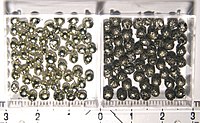
Photo from wikipedia
Abstract The components used in electrical power engineering may undergo different aging mechanisms. For some material combinations, this includes interdiffusion processes together with the formation of intermetallic compounds (IMC). As… Click to show full abstract
Abstract The components used in electrical power engineering may undergo different aging mechanisms. For some material combinations, this includes interdiffusion processes together with the formation of intermetallic compounds (IMC). As for some IMCs only few or inconsistent data regarding growth parameters or electrical properties at temperatures below 200 °C exist, it is challenging to estimate their influence on the durability of electrical components. In a series of research projects, for the systems aluminium-copper (Al-Cu), aluminium-silver (Al-Ag), silver-tin (Ag-Sn) and nickel-tin (Ni-Sn) data on the formation and growth parameters were gathered. For this, the IMCs forming at temperatures below 200 °C were identified, synthesised and structurally and electrically characterised. Parallelly, industrial samples like busbars or fuse elements were analysed and the growth behaviour and rates of the IMCs were determined. For Al-Cu, three IMCs (Al2Cu, AlCu and Al4Cu9) and for Ag-Al, two IMCs (Ag2Al and Ag3Al) could be identified. In Ag-Sn specimens, two IMCs (Ag3Sn and Ag4Sn) could be detected. Below 200 °C, Ni-Sn shows one IMC from the phase diagram (Ni3Sn4) and a second platelet shaped IMC which can be described as tetragonal NiSn3. From the electrical properties and the growth rates of the IMCs together with the results of long-term tests it can be concluded, that the influence of IMCs on the overall life-cycle and electrical resistance is not significant.
Journal Title: Intermetallics
Year Published: 2021
Link to full text (if available)
Share on Social Media: Sign Up to like & get
recommendations!